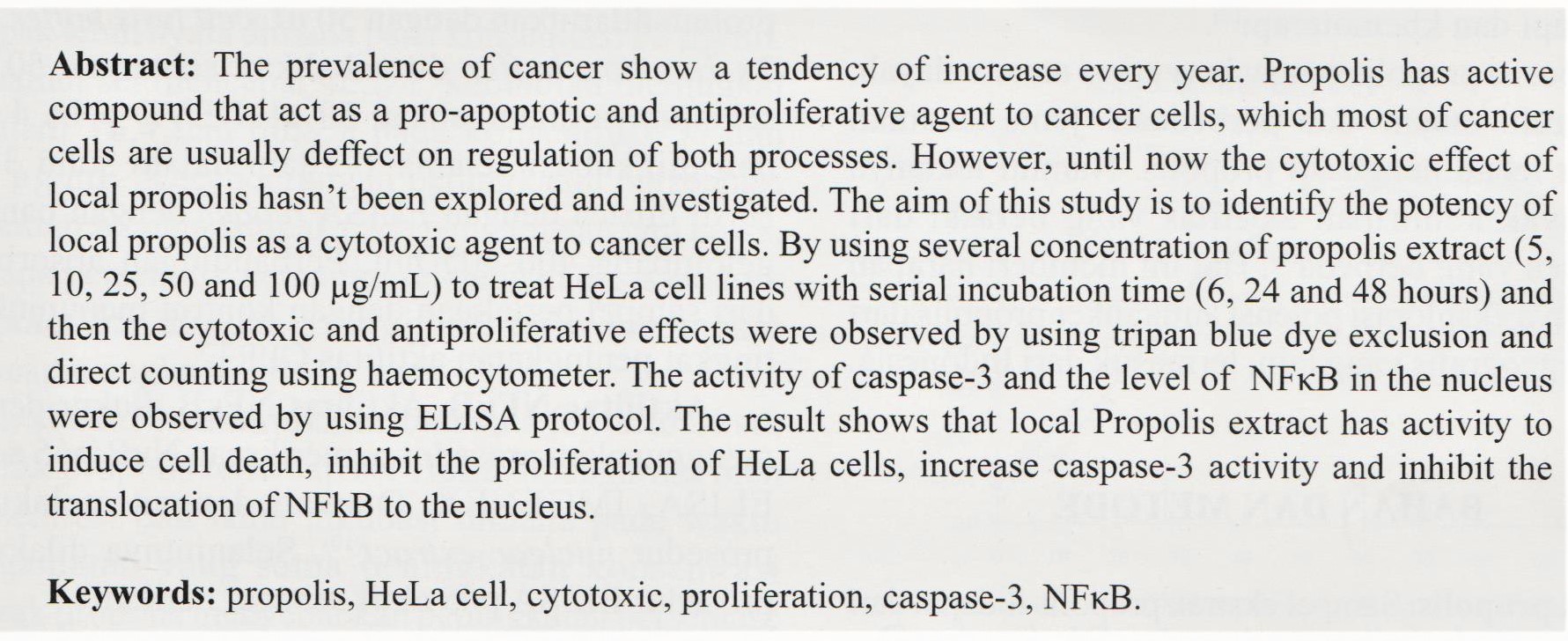Cytotoxic and Antiproliferative Effects of Propolis Extract to HeLa Cells Culture Through Acitivity Inhibition of NFKB
Abstract

References
2. Agarwal, Bharat B, Shishir S. Molecular targets of dietary agent for prevention and therapy of cancer. Biochemical Pharmacology. 2006. 1:1397-421.
3. Aso K, Kanno S, Tadano T, Satoh S, Ishikawa M. Inhibitory effect of propolis of the growth of human leukemia U937. Biomol Pharm Bull. 2004.27:727-30.
4. Ghosh S, May M, Kopp E. NF-kappa B and Rel proteins: evolutionarily conserved mediators of immune responses. Annu.Rev. Immunol. 1998.16:225-60.
5. Kanadaswami C, Lee LT, Lee PP, Hwang JJ, Ke FC, Huang YT, Lee MT. The antitumor activities of flavonoids. In Vivo. 2005.19:895-909.
6. Wang CY, Mayo MW, Korneluk RG, Goeddel DV, Baldwin AS. NF-kappa B antiapoptosis -induction of TMF1 and TRAF 2 and c-IAP 1 and c-IAP 2 to suppress caspase-8 activation. Science.1998.281:1680-83.
7. Wang W, Abbruzesse JL, Evans DB, et a]. The nuclear factor kappaB Rel Atranscription factor is constitutively activated in human pancreatic adenocarcinoma cells. CLin Cancer Res. 1999.5:119-27.
8. Salatino Antonio, Erica Weinstein, et al. Origin and chemical variation of Brazilian propolis. eCAM. 2005.2(1):33-8.
9. Szliszka E, Zenon P. Czuba, Katarzyna J, Wojciech K. Dietary havonoids sensitize HeLa cells to tumor necrosis factor-related apoptosis-inducing ligand (TRAIL). Int. J. Mol. Sci. 2008.9:56-64.
10. Frouin 1. Cell cycle dependent dynamic association of cyclin/Cdk complexes with human DNA replication protein. The EMBO Journal. 2002.21(10):2485-95.
11. Bu’falo MC, Joa MG, Candeias, Jose MS. In vitro cytotoxic effect of Brazilian green propolis on human laryngeal epidermoid carcinoma (HEp-2) cells. eCAM Advance Access; 2007.
12. Chia N, Meng S, Chia L, Jen K. Comparison of radical scavenging activity, cytotoxic effects and apoptosis induction in human melanoma cells by Taiwanese propolis from different sources. Evidenced-based Complementary and Alternative Medicine. 2004. 1(2).
13. Meiyantio E, Ratna A, Handayani A, Rahmi F. Ekstrak etanolik biji buah pinang (Areca catechu L.) mampu menghambat proliferasi dan memacu apoptosis sel MCF-7. Majalah Farmasi Indonesia. 2008.19(1).
14. Lee YJ, Kuo HC, Chu CY, Wang C], Lin WC, Tseng TH. Involvement of tumor suppressor protein p53 and p38 MAPK in caffeic acid phenethyl ester-induced apoptosis of C6 glioma cells. Biochem Pharmacol. 2003.66: 81-91.
15. Bhimani.HR, Troll W, Grunberger D, Frenkel K. Inhibition of oxidative stress in HeLa cells by chemopreventive agents. Cancer Res. 1993 .53 :4528-33.
16. Rayet B, Ge'linas C. Aberrant rel anb genes and activity in human cancer. Oncogene. 1999.18:693 8-47.
17. Natarajan K, Singh S, Burke Jr TR, Grunberger D, Aggarwal BB. Caffeic acid phenethyl ester is a potent and specific inhibitor of activation of nuclear rranscription factor NFKB. Proc Natl Acad Sci USA. 1996.93:9090-5.
18. Gutridge DC, Albanese C, Reuther JY, et a1. NF kappa B controls cells growth and differentiation through transcriptional regulation of cyclin D1. Mol Cell Biol. 1999.19:5785-99.
19. Nakashima T, Clyman GL. Antisense inhibition of cyclin D-l in human head and neck squamous cell carcinoma. Arch Otolaringol Haed Neck Surg. 2000. 126:957-61.
20. Chang F, Lee JT, Navolanic PM, Steelman LS, 21. Reed JC. Bel-2 Family Proteins: Regulators of Shelton JG, Blalock WL, et al. Involvement of P13K Akt pathway in cell cycle progression, apoptosis, malignancies and neoplastic transformation: a target for cancer chemotherapy. Leukemia. 2003.17(3):590-603.
21. . Reed JC. Bel-2 Family Proteins: Regulator of apoptosis and chemoresistance in hematologic malignancies. Semin Hematol. 1997. 34:9-19.
Licencing
All articles in Jurnal Ilmu Kefarmasian Indonesia are an open-access article, distributed under the terms of the Creative Commons Attribution-NonCommercial-ShareAlike 4.0 International License which permits unrestricted non-commercial used, distribution and reproduction in any medium.
This licence applies to Author(s) and Public Reader means that the users mays :
- SHARE:
copy and redistribute the article in any medium or format - ADAPT:
remix, transform, and build upon the article (eg.: to produce a new research work and, possibly, a new publication) - ALIKE:
If you remix, transform, or build upon the article, you must distribute your contributions under the same license as the original. - NO ADDITIONAL RESTRICTIONS:
You may not apply legal terms or technological measures that legally restrict others from doing anything the license permits.
It does however mean that when you use it you must:
- ATTRIBUTION: You must give appropriate credit to both the Author(s) and the journal, provide a link to the license, and indicate if changes were made. You may do so in any reasonable manner, but not in any way that suggests the licensor endorses you or your use.
You may not:
- NONCOMMERCIAL: You may not use the article for commercial purposes.
This work is licensed under a Creative Commons Attribution-NonCommercial-ShareAlike 4.0 International License.





 Tools
Tools





















